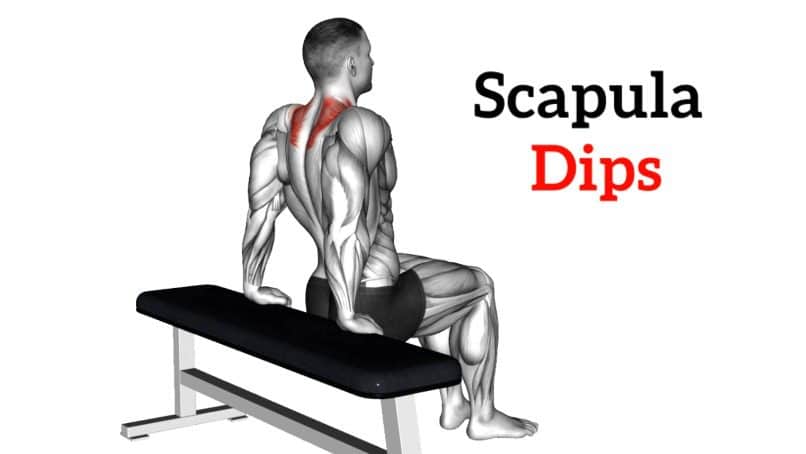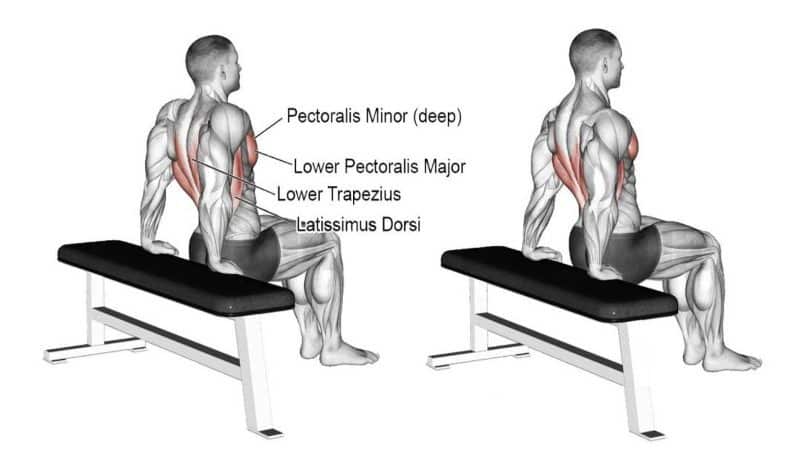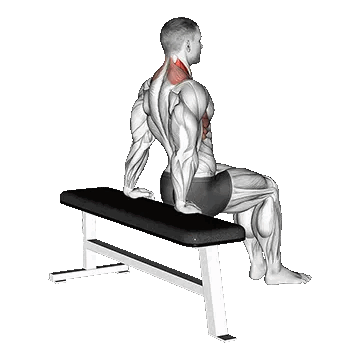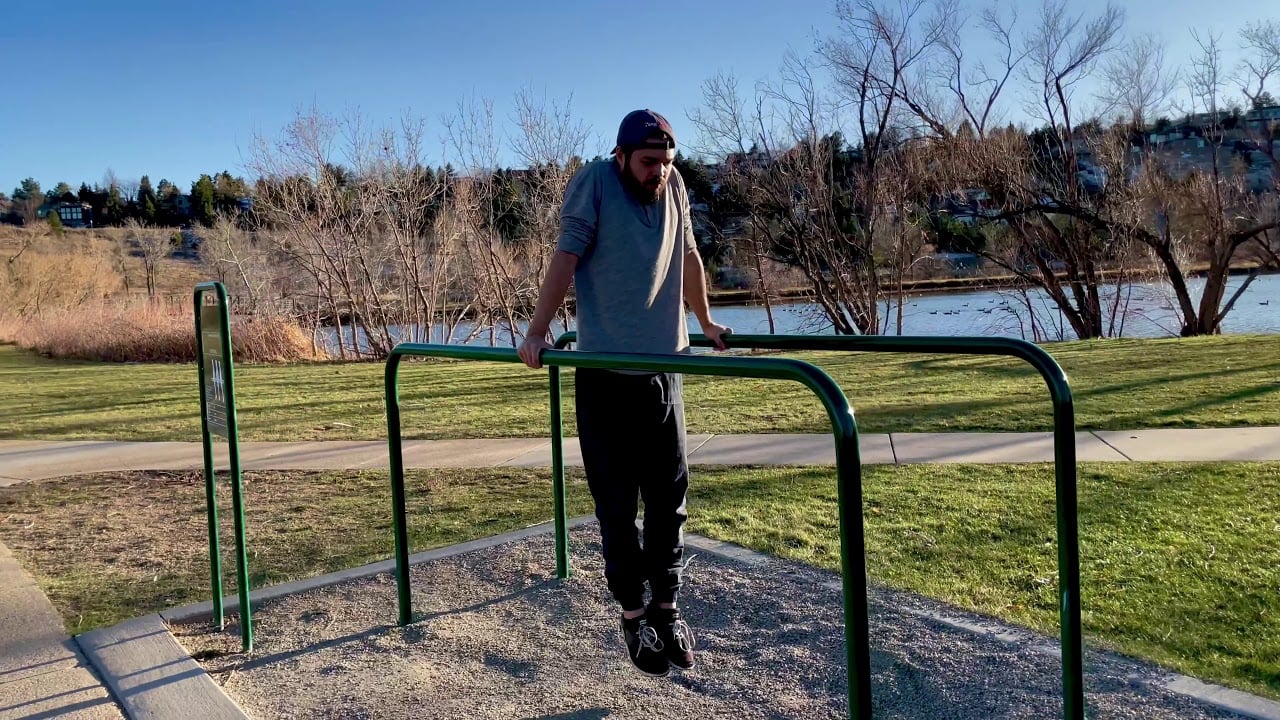If you’re having pain in your shoulder or upper back, or you might be dealing with an old shoulder injury, sitting at your desk for hours, or are very active but having trouble with pain.
Today, I will show you a simple yet highly effective exercise to improve your scapula mobility — scapula dips (Scap Dip). This movement will help restore the natural function of your scapula (the shoulder blade) and get it moving freely off your rib cage.
When the scapula doesn’t move properly, adhesions can form between the subscapularis (muscle underneath your shoulder blade) and the rib cage, locking down your shoulder and causing discomfort.
Scapula dips help your scapula move more naturally, which helps with shoulder stability, pain relief, and overall mobility.

Benefits Of Scapula Dips
- If you’re feeling tension in your upper traps from sitting too long, this exercise activates the lower traps that relieve and reduce strain.
- The scapula dip is a great exercise for strengthening scapular depression, essential for shoulder health and stability.
- This exercise can help you recover from a shoulder injury by loosening up adhesions and promoting better movement patterns.
- Pulling the scapula downward and against the rib cage helps to keep the scapula stable. Scapular depression prevents the shoulder blades from being rounded over and pulled forward.
- They can help you improve your balance, coordination, stability, and flexibility. They are an excellent choice for getting better at any sport or form of exercise.
- You don’t need any special equipment to practice the scap dip workout. All you require is the right technique and some willpower.
Want to take your gains to the next level? Discover your daily calorie needs with our free TDEE calculator
Scapula Dip Muscles Worked
- Primary Muscles: Lower Trapezius, Pectoralis Minor
- Secondary Muscles: Latissimus Dorsi, Rhomboids and Serratus Anterior.
- Stabilizing Muscles: Core Muscles, Deltoids and Forearm Muscles

How To Do Scapula Dip
- Place your hands on the side of a flat bench so that your body is perpendicular to the bench when you place your feet out in front of you. Your knees should be bent at a 90-degree angle.
- Keep your body upright and straight. Move your body towards the floor and let your ears touch your shoulders.
- Push your torso back to the starting position by driving your shoulder blades down.
- Perform 10–15 repetitions for 2–3 sets.

Tips and Techniques
- The key to scapula dips is slow, controlled movements. Rushing through the motion can lead to poor form and reduced effectiveness. Take time with each rep to fully engage your muscles and ensure the scapula moves correctly.
- It’s easy to shrug your shoulders during the upward movement inadvertently, but try to avoid this. The goal is to passively lift the shoulders towards the ears, not tense them up. This will help shut off the overactive upper traps and allow the lower traps to take over.
- Ensure you have a strong, steady grip on the chair or elevated surface. This will help you maintain proper alignment throughout the movement and keep your arms straight.
- As you move, visualize your shoulder blades sliding up and down on your rib cage like gliding on a smooth track. This mental cue helps ensure proper muscle activation and enhances your mind-muscle connection.
- Avoid tucking your chin or looking up. Keep your head in a neutral position, aligned with your spine, to avoid unnecessary strain on your neck.
- Keep your chest tall and your shoulder blades pulled back throughout the exercise.
- Ensure you maintain some tension in your abs and don’t allow your lower back to excessive arch.
- If you’re feeling too much strain in your wrists or shoulders, you can modify by sitting further back on the chair to reduce the weight load or using a higher surface for more support.
- If you’re new to scapula dips, start with 5–8 controlled reps and gradually increase as your shoulder mobility and strength improve.
Know More: 150+ Gym Workout Motivational Quotes (With Images)
Make It Easier Or Harder (Regression & Progression)
If you want to make Scapular dip easier, place your hands on a floor. Anyone can do this beginner version because you’re not lifting a large percentage of your body weight, and it doesn’t require as much flexibility.
To make the Capula retraction dip harder, increase the number of sets and the number of times you do them. Put a weight plate on your lap to make this exercise more challenging.
1. Floor Scapula Dip
The Scapular Floor Dip is a simple yet effective scap dips variation that you can do at home on the floor. They are easier than on high surfaces so that beginners can do them easily.
This variation makes it a safer option for those with shoulder instability or who are recovering from injury. It provides a controlled range of motion.
Like other variations, scapular dips on the floor target the lower trapezius and serratus anterior muscles. To do the floor scap dip, use a brick, dumbbell, or block (for free-range of motion).
2. Parallel Bar Scapula Dip
When you do scapular dips on parallel bars, you have a greater range of motion compared to floor or chair dips (but they are Difficult to do).
Since your body is suspended, your scapula can move more freely, which gives you a more dynamic shoulder blade movement and enhanced mobility.
This is particularly beneficial for athletes involved in sports or activities that demand shoulder stability (e.g., gymnastics, swimming, weightlifting).
References
- Contemori S, Panichi R, Biscarini A. Effects of scapular retraction/protraction position and scapular elevation on shoulder girdle muscle activity during glenohumeral abduction. Hum Mov Sci. 2019 Apr;64:55-66. doi: 10.1016/j.humov.2019.01.005. Epub 2019 Jan 16. PMID: 30660072.
- Nakamura Y, Tsuruike M, Ellenbecker TS. Electromyographic Activity of Scapular Muscle Control in Free-Motion Exercise. J Athl Train. 2016 Mar;51(3):195-204. doi: 10.4085/1062-6050-51.4.10. Epub 2016 Mar 17. PMID: 26986055; PMCID: PMC4852525.
- Escamilla RF, Yamashiro K, Paulos L, Andrews JR. Shoulder muscle activity and function in common shoulder rehabilitation exercises. Sports Med. 2009;39(8):663-85. doi: 10.2165/00007256-200939080-00004. PMID: 19769415.

Manish is a NASM-certified fitness and nutrition coach with over 10 years of experience in weight lifting and fat loss fitness coaching. He specializes in gym-based training and has a lot of knowledge about exercise, lifting technique, biomechanics, and more.
Through “Fit Life Regime,” he generously shares the insights he’s gained over a decade in the field. His goal is to equip others with the knowledge to start their own fitness journey.

